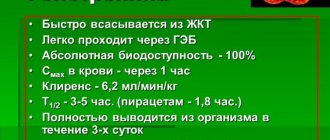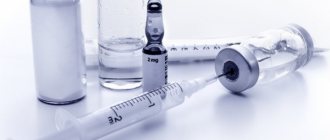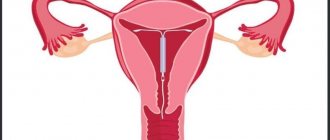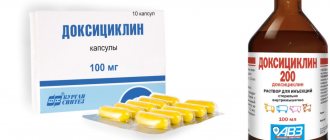Release form and composition
Dosage forms of Spazgan:
- Tablets (10 pieces each in blister packs, 2 or 10 packs in a cardboard pack);
- Solution for intramuscular and intravenous administration (5 ml in ampoules, 5 ampoules in plastic contour packages, 1 or 5 packages in a cardboard box; 5 ml in ampoules, 5 ampoules in a cardboard box).
Active ingredients of the drug:
- Metamizole sodium: in 1 tablet – 500 mg, in 1 ml of solution – 500 mg;
- Pitophenone hydrochloride: 1 tablet – 5 mg; in 1 ml of solution – 2 mg;
- Phenpiverinium bromide: in 1 tablet – 0.1 mg, in 1 ml of solution – 0.02 mg.
Composition of the drug
Active ingredients in Spazgan:
- metamizole sodium (which is a non-narcotic analgesic);
- fenpiverinium bromide;
- pitofenone hydrochloride (which is an antispasmodic).
It can be found on sale in tablet form. The pills are placed in the cells of contour packages. In addition, the medication is released in ampoules as a solution for injection (intravenously or intramuscularly). Instructions for using Spazgan are included in each pack.
Indications for use
Spazgan is used to relieve mild to moderate pain due to spasms of the smooth muscles of internal organs:
- Spasm of the ureter and bladder, renal colic;
- Biliary and intestinal colic;
- Chronic colitis, postcholecystectomy syndrome, biliary dyskinesia;
- Algodismenorrhea and diseases of the pelvic organs.
The drug is also used in the following cases:
- Symptomatic treatment of arthralgia, neuralgia, myalgia, sciatica;
- Reducing elevated body temperature during infectious-inflammatory and colds;
- Relief of pain after diagnostic procedures and surgical interventions.
"Spazmolgon"
"Spazmalgon" is a three-component, potent analgesic and antispasmodic drug. Contains fenpiverinium bromide, metamizole sodium and pitofenone hydrochloride, they mutually improve each other's action, and the result is achieved faster.
The drug "Spazmalgon" is produced in tablets and solutions for intravenous and intramuscular administration.
The scope of "Spazmalgon" is quite wide; it is often used in gynecology, nephrology, gastroenterology, and relieves pain and spasmodic attacks in internal organs. The drug is prescribed for:
- headaches, migraine-like conditions;
- toothache and pain after dental treatment;
- spasmodic pain in the stomach and intestines;
- spasms of smooth muscles in the bladder and ureters;
- urolithiasis (with renal colic);
- hepatic colic due to cholelithiasis;
- dyskinesia;
- pain after gall bladder surgery;
- menstrual pain;
- neuralgia, pain in joints, muscles.
Contraindications
Absolute:
- Severe liver/renal failure;
- Angle-closure glaucoma;
- Inhibition of bone marrow hematopoiesis;
- Glucose-6-phosphate dehydrogenase deficiency;
- Decompensated chronic heart failure;
- Severe angina;
- Tachyarrhythmias;
- Megacolon;
- Intestinal obstruction;
- Collaptoid states;
- Prostatic hyperplasia (with clinical manifestations);
- Children up to 3 months of age (or the child’s body weight less than 5 kg) - for intravenous administration, up to 5 years - for tablets;
- Pregnancy, especially the first trimester and the last 6 weeks;
- Lactation period;
- Hypersensitivity to the components of the drug or pyrazolone derivatives.
Relative (special care required);
- Bronchial asthma;
- Kidney/liver failure;
- Tendency to arterial hypotension;
- Hypersensitivity to non-steroidal anti-inflammatory drugs (NSAIDs);
- History of urticaria or acute rhinitis caused by taking acetylsalicylic acid or other NSAIDs.
SPAZGAN (tablets): reviews
Good day! I especially warmly greet all VSD sufferers and weather-dependent people who periodically suffer from severe headaches and the like. I was diagnosed with VSD (vegetative-vascular dystonia) when I was in school, more than 20 years ago... Well, how else can our neurologists most often explain dizziness, lack of air, and severe headaches? VSD, definitely. And once, based on the results, I was diagnosed with dystonia of the cerebral vessels of the brain... Wow, I was scared then. But nothing... I live on. While studying at the university, under heavy mental stress before the next session, sometimes I just woke up at night and... howled into the pillow... from a severe headache. (I’ll note right away that my pain threshold is quite high: even my teeth …read more
I try to treat without anesthesia if possible. The only thing is that I screamed loudly and called my mother while pushing - so far for me this is the most vivid memory of severe pain). At that moment, during my studies, various analgesics, painkillers, nootropic drugs, etc. were tried, such as: Analgin, Baralgin, Pentalgin, Tempalgin, Nurofen, Ketanov... and this series can be continued... But sometimes nothing helped : I just had to wait out the migraine, putting up with the pain. With age, weather dependence also appeared. Attacks of headaches always happen when the weather changes, which in Siberia has been changing like crazy lately. Now it's down to minus 30 - and it's just beautiful! I learned about the hero of the review, the drug SPAZGAN, not so long ago from my mother-in-law and sister-in-law. Now I regret that I didn’t know about him earlier. Spazgan is a combination drug: it is both a non-narcotic analgesic and an antispasmodic. You can buy it at any pharmacy. Over the counter. The last time a pack of 20 tablets was bought for 95 rubles. The price is very reasonable. Moreover, my consumption is economical, since the pain most often goes away after using one tablet. Manufacturer: VOKKARD, Limited (India). Shelf life: 3 years. The release form of this drug comes in several types: Tablets 500 mg + 5 mg + 100 mcg - 20 or 100 pcs. Solution for injection 2.5 g+10 mg+100 mcg/5 ml - amp. 5 or 25 pcs. I'm only familiar with tablets so far. Packaging: in a cardboard case there are 2 cell contour blisters, each of which contains 10 tablets, and instructions. The tablets are round, flat, with a beveled edge, white with a slightly yellowish tint, with a dividing line on one side and an emblem on the other. Two sides of one tablet The tablet is of normal size and is easy to swallow, but it is advisable to wash it down with a small amount of water. It tastes bitter, disgusting, and somehow reminds me of Analgin. But I assure you that there are tablets that taste worse, for example, I’m taking these now, and I’ll write about the result later. Composition: Composition 1 TABLET: metamizole sodium - 500 mg; pitofenone hydrochloride - 5 mg; fenpiverinium bromide - 100 mcg. These components in combination have an enhanced analgesic effect along with an antispasmodic effect. Metamizole sodium, a pyrazolone derivative, has an analgesic, antipyretic and weak anti-inflammatory effect, the mechanism of which is associated with inhibition of prostaglandin synthesis. Pitophenone hydrochloride has a direct myotropic effect on the smooth muscles of internal organs and causes its relaxation (papaverine-like effect). Phenpiverinium bromide has an m-anticholinergic effect and has an additional myotropic effect on smooth muscles. Pharmacological action: Therapeutic effects: Analgesic effect; Anti-inflammatory effect; Antipyretic effect; Relaxation of smooth muscles; Blocking m-acetylcholine receptors; Inhibition of prostaglandin synthesis. INDICATIONS FOR USE Pain with smooth muscle spasms of weak or moderate strength. An auxiliary analgesic drug in the postoperative period. Short-term symptomatic treatment of pain of various origins. Pain and increased body temperature during infectious and inflammatory diseases. I use Spazgan during PMS, when my lower back begins to hurt badly. Or for a migraine. Spazgan in tablet form is not recommended for use in children under 5 years of age. The drug is administered orally, without chewing, with a small amount of liquid. Recommended dosage: age 6-8 years: half a tablet of the drug three times a day; 9-12 years: three quarters of a tablet of the drug three times a day; 13-15 years: one tablet of the drug three times a day; patients over 15 years of age and adult patients: one or two tablets three times a day; You can use no more than 6 tablets per day!!! So far I have used a maximum of 3 tablets per day. The course of treatment should not exceed 5 days. For me, the pill begins to act 15 minutes after taking it: the pain either goes away completely (most often) or subsides significantly, gradually disappearing. Of course, I try not to abuse medications, but sometimes without them, living with pain becomes simply unbearable. Then Spazgan comes to my aid. It has an analogue - Spazmalgon, but Spazgan helps me relieve headaches better and faster. Be careful, as Spazgan has CONTRAINDICATIONS: Functional disorders of the kidneys; Congenital deficiency of the enzyme glucose-6-phosphate dehydrogenase; Various diseases of the hematopoietic system; Presence of a benign prostate tumor; Use in the first and third trimesters of pregnancy; Enlarged rectum; Lowering blood pressure to critical values; Use during breastfeeding; Hypersensitivity to Spazgan or its components; Age less than five years (Spazgan in tablet form); Functional disorders of the liver; Heart rhythm disturbances; Increased intraocular pressure; Presence of intestinal obstruction in patients; Individual intolerance to Spazgan or its components; Patients' tendency to develop bronchial spasms; Age less than one year of life (the drug is in the form of an injection solution). Thank you for your attention! I wish everyone good Siberian health!
Good day! I especially warmly greet all VSD sufferers and weather-dependent people who periodically suffer from severe headaches and the like. I was diagnosed with VSD (vegetative-vascular dystonia) when I was in school, more than 20 years ago... Well, how else can our neurologists most often explain dizziness, lack of air, and severe headaches? VSD, definitely. And once, based on the results, I was diagnosed with dystonia of the cerebral vessels of the brain... Wow, I was scared then. But nothing... I live on. While studying at the university, under heavy mental stress before the next session, sometimes I just woke up at night and... howled into the pillow... from a severe headache. (I’ll note right away that my pain threshold is quite high: I even try to treat my teeth without anesthesia whenever possible. The only thing is that I screamed loudly and called for my mother while pushing - so far for me this is the most vivid memory of severe pain). At that moment, during my studies, various analgesics, painkillers, nootropic drugs, etc. were tried, such as: Analgin, Baralgin, Pentalgin, Tempalgin, Nurofen, Ketanov... and this series can be continued... But sometimes nothing helped : I just had to wait out the migraine, putting up with the pain. With age, weather dependence also appeared. Attacks of headaches always happen when the weather changes, which in Siberia has been changing like crazy lately. Now it's down to minus 30 - and it's just beautiful! I learned about the hero of the review, the drug SPAZGAN, not so long ago from my mother-in-law and sister-in-law. Now I regret that I didn’t know about him earlier. Spazgan is a combination drug: it is both a non-narcotic analgesic and an antispasmodic. You can buy it at any pharmacy. Over the counter. The last time a pack of 20 tablets was bought for 95 rubles. The price is very reasonable. Moreover, my consumption is economical, since the pain most often goes away after using one tablet. Manufacturer: VOKKARD, Limited (India). Shelf life: 3 years. The release form of this drug comes in several types: Tablets 500 mg + 5 mg + 100 mcg - 20 or 100 pcs. Solution for injection 2.5 g+10 mg+100 mcg/5 ml - amp. 5 or 25 pcs. I'm only familiar with tablets so far. Packaging: in a cardboard case there are 2 cell contour blisters, each of which contains 10 tablets, and instructions. The tablets are round, flat, with a beveled edge, white with a slightly yellowish tint, with a dividing line on one side and an emblem on the other. Two sides of one tablet The tablet is of normal size and is easy to swallow, but it is advisable to wash it down with a small amount of water. It tastes bitter, disgusting, and somehow reminds me of Analgin. But I assure you that there are tablets that taste worse, for example, I’m taking these now, and I’ll write about the result later. Composition: Composition 1 TABLET: metamizole sodium - 500 mg; pitofenone hydrochloride - 5 mg; fenpiverinium bromide - 100 mcg. These components in combination have an enhanced analgesic effect along with an antispasmodic effect. Metamizole sodium, a pyrazolone derivative, has an analgesic, antipyretic and weak anti-inflammatory effect, the mechanism of which is associated with inhibition of prostaglandin synthesis. Pitophenone hydrochloride has a direct myotropic effect on the smooth muscles of internal organs and causes its relaxation (papaverine-like effect). Phenpiverinium bromide has an m-anticholinergic effect and has an additional myotropic effect on smooth muscles. Pharmacological action: Therapeutic effects: Analgesic effect; Anti-inflammatory effect; Antipyretic effect; Relaxation of smooth muscles; Blocking m-acetylcholine receptors; Inhibition of prostaglandin synthesis. INDICATIONS FOR USE Pain with smooth muscle spasms of weak or moderate strength. An auxiliary analgesic drug in the postoperative period. Short-term symptomatic treatment of pain of various origins. Pain and increased body temperature during infectious and inflammatory diseases. I use Spazgan during PMS, when my lower back begins to hurt badly. Or for a migraine. Spazgan in tablet form is not recommended for use in children under 5 years of age. The drug is administered orally, without chewing, with a small amount of liquid. Recommended dosage: age 6-8 years: half a tablet of the drug three times a day; 9-12 years: three quarters of a tablet of the drug three times a day; 13-15 years: one tablet of the drug three times a day; patients over 15 years of age and adult patients: one or two tablets three times a day; You can use no more than 6 tablets per day!!! So far I have used a maximum of 3 tablets per day. The course of treatment should not exceed 5 days. For me, the pill starts to work 15 minutes after taking it: the pain either goes away completely (most often) or subsides significantly, gradually disappearing. Of course, I try not to abuse medications, but sometimes without them, living with pain becomes simply unbearable. Then Spazgan comes to my aid. It has an analogue - Spazmalgon, but Spazgan helps me relieve headaches better and faster. Be careful, as Spazgan has CONTRAINDICATIONS: Functional disorders of the kidneys; Congenital deficiency of the enzyme glucose-6-phosphate dehydrogenase; Various diseases of the hematopoietic system; Presence of a benign prostate tumor; Use in the first and third trimesters of pregnancy; Enlargement of the rectum; Lowering blood pressure to critical values; Use during breastfeeding; Hypersensitivity to Spazgan or its components; Age less than five years (Spazgan in tablet form); Functional disorders of the liver; Heart rhythm disturbances; Increased intraocular pressure; Presence of intestinal obstruction in patients; Individual intolerance to Spazgan or its components; Patients' tendency to develop bronchial spasms; Age less than one year of life (the drug is in the form of an injection solution). Thank you for your attention! I wish everyone good Siberian health!
Rating: 5 5
Source:
irecommend.ru
Directions for use and dosage
Spazgan tablets should be taken orally, preferably after meals, without chewing, with water.
Adults and adolescents over 15 years of age are usually prescribed 1-2 tablets 2-3 times a day. The maximum daily dose is 6 tablets.
The drug can be given to children only as prescribed by a doctor. Doses depending on age (recommended single/maximum daily):
- 12-14 years old – 1 tablet / 6 tablets. (1.5 tablets 4 times a day);
- 8-11 years – 0.5 tablets/4 tablets. (1 tablet 4 times a day);
- 5-7 years – 0.5 tablets/2 tablets. (0.5 tablets 4 times a day).
The duration of taking Spazgan is no more than 5 days.
Increasing the daily dose or duration of treatment is possible only on the recommendation of a doctor.
Spazgan solution is intended for intramuscular (IM) and intravenous (IV) administration. Before injection, the solution should be warmed in your hand.
For adults and adolescents over 15 years of age with acute severe colic, the drug is administered:
- Intravenously slowly (at a rate of 1 ml/minute) in a dose of 2 ml. If necessary, a second injection is given after 6-8 hours;
- Intramuscularly at a dose of 2-5 ml 2-3 times a day.
The maximum daily dose is 10 ml, duration of treatment is up to 5 days.
Recommended doses and route of administration for children:
- 12-15 years: IM or IV 0.8-1 ml;
- 8-12 years (31-45 kg): IM 0.6-0.7 ml or IV 0.5-0.6 ml;
- 5-7 years (24-30 kg): IM 0.4-0.5 ml or IV 0.3-0.4 ml;
- 3-4 years (16-23 kg): IM 0.3-0.4 ml or IV 0.2-0.3;
- 1-2 years (9-15 kg): IM 0.2-0.3 ml or IV 0.1-0.2 ml;
- 3-11 months (5-8 kg): only IM at a dose of 0.1-0.2 ml.
Side effects
In therapeutic doses, Spazgan is usually well tolerated. In some cases, the following side effects are observed:
- Urinary system: red staining of urine, anuria, oliguria, proteinuria, renal dysfunction, interstitial nephritis;
- Anticholinergic effects: accommodation paresis, decreased sweating, difficulty urinating, dry mouth, tachycardia;
- Cardiovascular system: decreased blood pressure;
- Hematopoietic system: leukopenia, thrombocytopenia, agranulocytosis (may manifest with symptoms such as chills, unmotivated rise in body temperature, difficulty swallowing, sore throat, stomatitis, as well as proctitis or vaginitis);
- Allergic reactions: urticaria (including on the mucous membranes of the nasopharynx and conjunctiva), angioedema; rarely - anaphylactic shock, bronchospastic syndrome, malignant exudative erythema, toxic epidermal necrolysis;
- Local reactions with intramuscular injection: infiltrates at the injection site.
Symptoms of overdose: vomiting, pain in the epigastric region, nausea, drowsiness, decreased blood pressure, confusion, impaired renal and liver function, convulsions. In this case, you should do a gastric lavage and take activated charcoal; further treatment is symptomatic.
pharmachologic effect
Spazgan is a combination drug with an analgesic and antispasmodic component. Spazgan is a combination of three drugs: metamizole sodium + pitofenone + fenpiverinium bromide, which have a rapid and long-lasting antispasmodic effect with a simultaneous analgesic effect. Metamizole sodium belongs to the group of non-narcotic analgesics, being a pyrazolone derivative. The main effects of the drug are associated with the suppression of the activity of prostaglandin H-synthetase, which is accompanied by inhibition of the formation of prostaglandins, and a decrease in their effect on sensitivity to bradykinin, which stimulates pain nerve endings, and as a result, pain is relieved and inflammatory reactions are moderately relieved. The release of prostaglandins in thermoregulation centers is inhibited, which increases heat transfer and eliminates the manifestations of fever, without reducing normal body temperature. Pitophenone hydrochloride is a myotropic antispasmodic agent with a targeted effect on the layer of smooth muscle fibers of internal organs. The effect of pitofenone hydrochloride is manifested by relaxation of smooth muscles with a pronounced antispasmodic effect. Fenpiverinium bromide is considered a representative of the group of M-anticholinergics, has a blocking effect on the endings of parasympathetic nerve fibers, which is accompanied by a decrease in the tone of the smooth muscles of the stomach, gall bladder and ducts, urinary system, reduces intestinal motility, and causes additional antispasmodic and analgesic effects. The combined effect of a drug manifests itself in the form of synergism of medicinal substances, and is manifested by a mutual enhancement of their pharmacological action. The primary pharmacological result of the drug occurs 20-40 minutes after oral administration, the maximum effect is observed after 120 minutes. Elimination occurs mainly in the urine, with a small amount excreted in the bile.
special instructions
With long-term (more than 1 week) use of Spazgan, it is necessary to monitor the peripheral blood picture and the functional state of the liver.
During treatment you should not drink alcoholic beverages.
If signs appear that suggest the presence of agranulocytosis or thrombocytopenia, the drug should be discontinued.
Until the cause is determined, it is prohibited to use Spazgan to relieve acute abdominal pain.
Intolerance to the drug is extremely rare, but the risk of developing anaphylactic shock after intravenous administration of the solution is slightly higher than after taking tablets orally. Patients with hay fever and atopic bronchial asthma are at higher risk of developing allergic reactions.
Parenteral Spazgan should be used only in cases where oral administration is not possible (for example, due to impaired absorption from the gastrointestinal tract). When introducing more than 2 ml of solution, special care must be taken, because there is a possibility of a sharp decrease in blood pressure. The intravenous injection should be given slowly, with the patient lying down, under monitoring of blood pressure, respiratory rate and heart rate. For intramuscular administration, you need to use a long needle.
Children under 5 years of age and patients receiving cytostatics should be under medical supervision during treatment.
Due to the release of the metabolite, Spazgan can turn urine red; this phenomenon has no clinical significance.
During therapy, caution is recommended for persons driving vehicles and performing potentially hazardous activities that require quick reactions.
Analogs
Effective drugs that can be used as substitutes for Spazgan:
- Spasmalgon;
- Maxigan;
- Renalgan;
- Trinalgin;
- Spasmaton;
- Spasmopharm;
- Spazgan Neo.
If Spazgan does not help for toothache or provokes side effects, the doctor recommends replacing this medication with an analogue with a more effective or gentle effect in the affected body. There are many so-called “substitutes”, but the best in a given direction are the following: Spazmalgon, Bralangin, Baralgetas, Bioralgin, Renalgan.
Differences between Spazgan and Spazmalgon
Most often, patients using modern antispasmodics ask the question: which is better Spazgan or Spazmalgon?
Spazmalin, Spazmalgon, Plenalgin, Revalgin, Renalgan, Bral, Bralangin.
Drug interactions
The pharmaceutical injection solution is incompatible with any other medications.
During treatment with drugs containing metamizole sodium, including Spazgan, colloidal blood substitutes, penicillin and radiocontrast agents should not be used.
Histamine H1 blockers, tricyclic antidepressants, butyrophenones, phenothiazines, amantadine and quinidine can enhance the m-anticholinergic effect of Spazgan.
Phenylbutazone, barbiturates and other inducers of liver enzymes reduce the analgesic effect of metamizole sodium, and anxiolytics (tranquilizers) and sedatives increase it.
Metamizole sodium, in turn, can enhance the severity of the effects of glucocorticosteroids, oral hypoglycemic drugs, indirect anticoagulants and indomethacin.
The effect of Spazgan is enhanced by H2-histamine receptor blockers, codeine and propranolol.
Allopurinol, tricyclic antidepressants and oral contraceptives increase the toxicity of the drug.
With the simultaneous use of chlorpromazine and other phenothiazine derivatives, the risk of developing severe hyperthermia increases; cytostatics and thiamazole – leukopenia.
Spazgan helps reduce the concentration of cyclosporine in the blood and enhances the effects of ethanol.
What does Spazgan help with?
The drug Spazgan is indicated for:
- painful menstruation (algodismenorrhea);
- spastic pain syndrome along the intestine;
- symptomatic therapy for neuralgia, myalgia, joint pain;
- moderate or mild pain resulting from spasm of the smooth muscles of internal organs.
As an adjuvant, Spazgan is used to reduce pain after diagnostic and surgical interventions.
A drug that relieves spasms of smooth muscles and has an analgesic effect.
Metamizole sodium is a non-narcotic analgesic, pitofenone hydrochloride is a myotropic antispasmodic that has a direct effect on the smooth muscles of internal organs, and fenpiverinium bromide is an anticholinergic blocker that complements the relaxing effect. It is in this combination that the pharmacological effects mutually enhance, which reduce elevated body temperature and relieve pain by relaxing smooth muscles.











